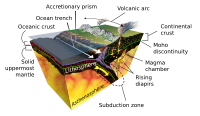
Photo from wikipedia
Abstract Understanding the evolution of nitrogen (N) across Earth's history requires a comprehensive understanding of N's behaviour in the Earth's mantle – a massive reservoir of this volatile element. Investigation… Click to show full abstract
Abstract Understanding the evolution of nitrogen (N) across Earth's history requires a comprehensive understanding of N's behaviour in the Earth's mantle – a massive reservoir of this volatile element. Investigation of terrestrial N systematics also requires assessment of its evolution in the Earth's atmosphere, especially to constrain the N content of the Archaean atmosphere, which potentially impacted water retention on the post-accretion Earth, potentially causing enough warming of surface temperatures for liquid water to exist. We estimated the proportion of recycled N in the Earth's mantle today, the isotopic composition of the primitive mantle, and the N content of the Archaean atmosphere based on the recycling rates of N in modern-day subduction zones. We have constrained recycling rates in modern-day subduction zones by focusing on the mechanism and efficiency of N transfer from the subducting slab to the sub-arc mantle by both aqueous fluids and slab partial melts. We also address the transfer of N by aqueous fluids as per the model of Li and Keppler (2014) . For slab partial melts, we constrained the transfer of N in two ways – firstly, by an experimental study of the solubility limit of N in melt (which provides an upper estimate of N uptake by slab partial melts) and, secondly, by the partitioning of N between the slab and its partial melt. Globally, 45–74% of N introduced into the mantle by subduction enters the deep mantle past the arc magmatism filter, after taking into account the loss of N from the mantle by degassing at mid-ocean ridges, ocean islands and back-arcs. Although the majority of the N in the present-day mantle remains of primordial origin, our results point to a significant, albeit minor proportion of mantle N that is of recycled origin ( 17 ± 8 % or 12 ± 5 % of N in the present-day mantle has undergone recycling assuming that modern-style subduction was initiated 4 or 3 billion years ago, respectively). This proportion of recycled N is enough to cause a departure of N isotopic composition of the primitive mantle from today's δ 15 N of −5‰ to − 6.8 ± 0.9 ‰ or − 6.3 ± 1.2 ‰ . Future studies of Earth's parent bodies based on the bulk Earth N isotopic signature should take into account these revised values for the δ 15 N composition of the primitive mantle. Also, the Archaean atmosphere had a N partial pressure of 1.4–1.6 times higher than today, which may have warmed the Earth's surface above freezing despite a faint young Sun.
Journal Title: Earth and Planetary Science Letters
Year Published: 2018
Link to full text (if available)
Share on Social Media: Sign Up to like & get
recommendations!